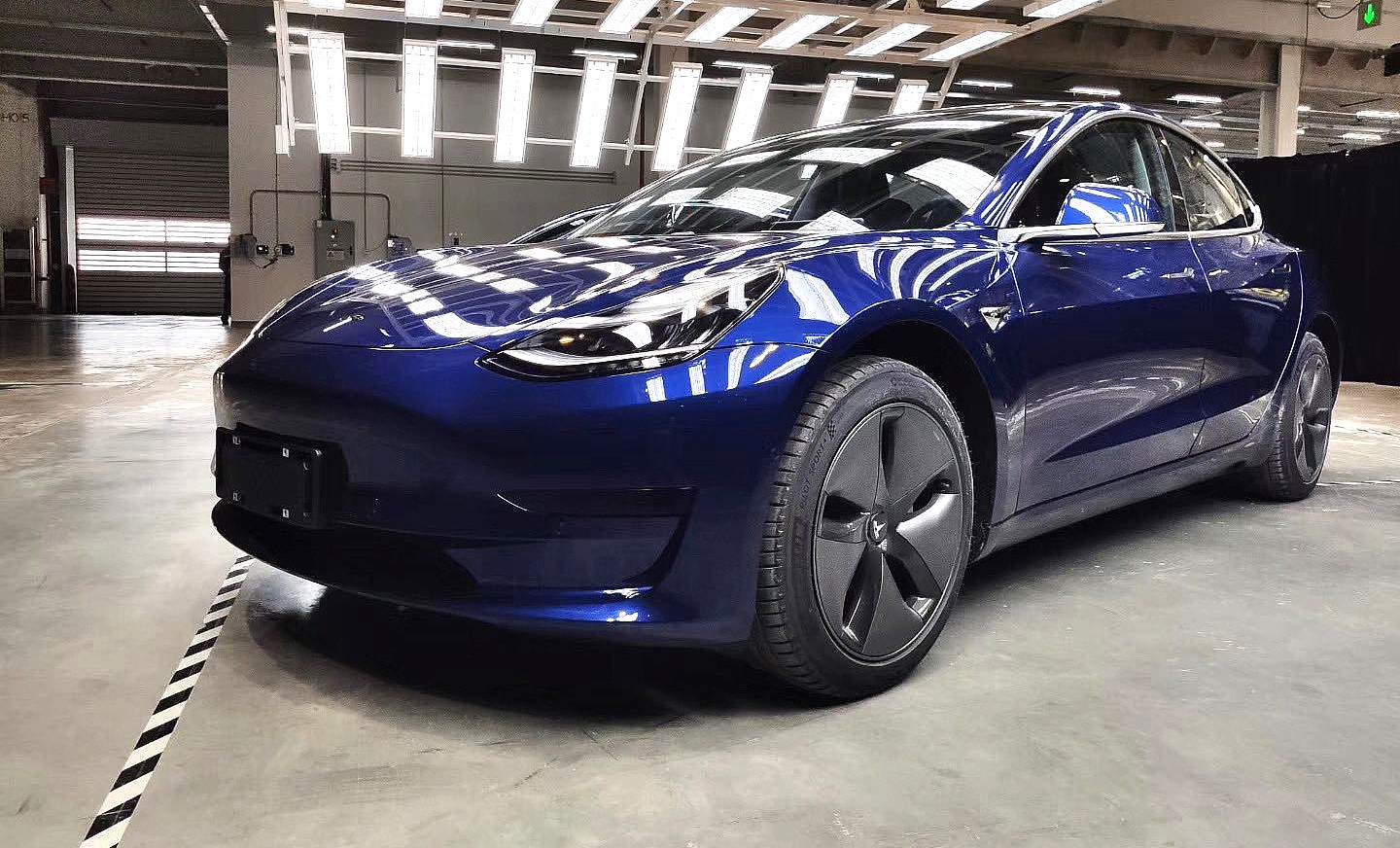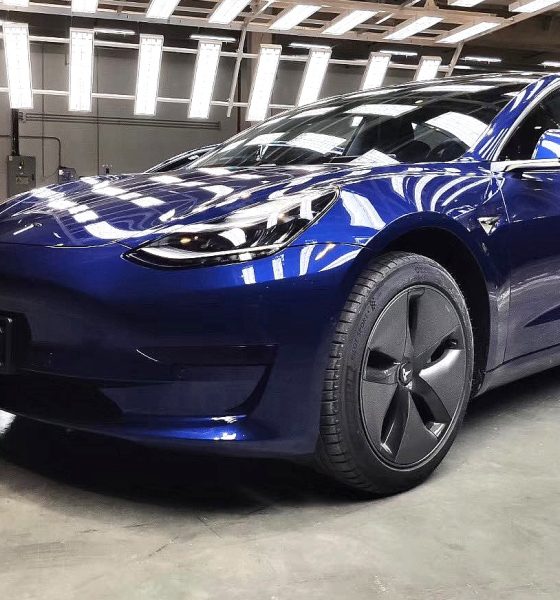

News
Tesla is breaking the 'Made-in-China' stereotype with the GF3-made Model 3
Elon Musk and the Tesla team revel in busting stereotypes. This was evident in the Cybertruck’s unveiling, where Chief Designer Franz von Holzhausen literally took a sledgehammer to emphasize the point that EVs can be stronger than conventional rough-and-tough vehicles. In China, Tesla is doing the same thing, but this time, the electric car maker is breaking a stereotype that has been around for a long time: the myth of bad “Made in China” quality.
A study from the Iowa State University reported via Futurity noted that before the words “Made in China” were perceived in the United States as a reference to low-cost and low-quality goods, the perception for Chinese-made products was actually quite positive. Gang (Kevin) Han, an associate professor at Iowa State University’s Greenlee School of Journalism and Communication, noted that things started changing when China became the manufacturing powerhouse that it is today.
“People really enjoyed products from China. They viewed products, such as tea, furniture, or dishware, as unique. It was a quality product and there was a cultural value. But when China became a world factory and produced so many items for so many brands, people changed their views,” he said, adding that the prominent media coverage about issues with China-made products also added to the stereotype. “We see a lot of framed messages in these stories and receive the message subconsciously,” Han remarked.
These stereotypes were promptly invoked by Tesla critics as soon as the electric car maker announced its plans to build a factory in China. Over the course of Gigafactory 3’s construction, it was not rare to find a Tesla critic mocking the alleged quality issues that would most likely plague the MIC Model 3. This point, as with many criticisms thrown at Tesla, appears to have been taken as a challenge by the electric car maker’s team in China. When the company invited the media to experience the Made-in-China Model 3 for the first time, Tesla was serious. It wanted to break another stereotype. And they did.
Reviews of the Made-in-China Model 3 were notably positive, even if the vehicles being produced in the Shanghai-based site are only the Standard Range Plus variants of the all-electric sedan. Despite not having Tesla’s stunning white interior or more fancy 19″ Sports Wheels, the locally-made Model 3s were built with near-surgical precision. The vehicles’ panel gaps were meticulously aligned, their trimmings fit to a tee. In the United States, former GM executive Bob Lutz eventually praised Tesla’s build quality for the Model 3, but only after Tesla mastered the production of the vehicle, which took over a year to achieve. The MIC Model 3 units in China were first production cars, which means that they’ll likely only get better with time.
It’s a bit humorous, but Tesla China’s press images for the MIC Model 3 featured numerous close-ups of the locally-made electric car, and many of them showcased the cars’ smooth paint and consistent panel lines, aspects of the car that proved difficult for the company in the United States. In a way, Tesla China’s MIC Model 3 press images seem to be a direct response against the stereotype, proving that any vehicle made in Shanghai’s Gigafactory 3 matches the quality of a car built in Fremont.
Perhaps most telling of these observations came from local auto journalists who were among the first to review the locally-made Model 3. Tencent Auto editor 常岩, who happens to be a Model 3 owner himself, was invited to check out the locally-made version of his electric car. Much to the auto editor’s surprise, he noted that the build quality of the Gigafactory 3-made Model 3 was actually better than his car, which was imported from the United States. With this conclusion, the auto journalist noted that Tesla’s MIC Model 3 will likely prove successful in the Chinese market, as it offers great quality and features for its price. The locally-made Model 3 is proudly Made in China, and it is just as good, if not better, than other Model 3 in the market.
Tesla’s Made-in-China Model 3 is poised to make waves in the Chinese EV segment, with the massive Shanghai-based Gigafactory 3 now mass manufacturing the all-electric sedan. Recent flyovers of the Gigafactory 3 complex have revealed hundreds of MIC Model 3 just ready for delivery. Car carrier trucks loaded with Model 3s have also been photographed leaving the Gigafactory 3 premises. With these sightings in mind, it may only be a matter of time before deliveries of the locally-made electric car begins in the country.
Watch an existing Tesla Model 3 owner review the MIC Model 3 in the video below.
H/T Ray4Tesla/Twitter

News
Tesla FSD fleet is nearing 7 billion total miles, including 2.5 billion city miles
As can be seen on Tesla’s official FSD webpage, vehicles equipped with the system have now navigated over 6.99 billion miles.

Tesla’s Full Self-Driving (Supervised) fleet is closing in on almost 7 billion total miles driven, as per data posted by the company on its official FSD webpage.
These figures hint at the massive scale of data fueling Tesla’s rapid FSD improvements, which have been quite notable as of late.
FSD mileage milestones
As can be seen on Tesla’s official FSD webpage, vehicles equipped with the system have now navigated over 6.99 billion miles. Tesla owner and avid FSD tester Whole Mars Catalog also shared a screenshot indicating that from the nearly 7 billion miles traveled by the FSD fleet, more than 2.5 billion miles were driven inside cities.
City miles are particularly valuable for complex urban scenarios like unprotected turns, pedestrian interactions, and traffic lights. This is also the difference-maker for FSD, as only complex solutions, such as Waymo’s self-driving taxis, operate similarly on inner-city streets. And even then, incidents such as the San Francisco blackouts have proven challenging for sensor-rich vehicles like Waymos.
Tesla’s data edge
Tesla has a number of advantages in the autonomous vehicle sector, one of which is the size of its fleet and the number of vehicles training FSD on real-world roads. Tesla’s nearly 7 billion FSD miles then allow the company to roll out updates that make its vehicles behave like they are being driven by experienced drivers, even if they are operating on their own.
So notable are Tesla’s improvements to FSD that NVIDIA Director of Robotics Jim Fan, after experiencing FSD v14, noted that the system is the first AI that passes what he described as a “Physical Turing Test.”
“Despite knowing exactly how robot learning works, I still find it magical watching the steering wheel turn by itself. First it feels surreal, next it becomes routine. Then, like the smartphone, taking it away actively hurts. This is how humanity gets rewired and glued to god-like technologies,” Fan wrote in a post on X.
News
Tesla starts showing how FSD will change lives in Europe
Local officials tested the system on narrow country roads and were impressed by FSD’s smooth, human-like driving, with some calling the service a game-changer for everyday life in areas that are far from urban centers.

Tesla has launched Europe’s first public shuttle service using Full Self-Driving (Supervised) in the rural Eifelkreis Bitburg-Prüm region of Germany, demonstrating how the technology can restore independence and mobility for people who struggle with limited transport options.
Local officials tested the system on narrow country roads and were impressed by FSD’s smooth, human-like driving, with some calling the service a game-changer for everyday life in areas that are far from urban centers.
Officials see real impact on rural residents
Arzfeld Mayor Johannes Kuhl and District Administrator Andreas Kruppert personally tested the Tesla shuttle service. This allowed them to see just how well FSD navigated winding lanes and rural roads confidently. Kruppert said, “Autonomous driving sounds like science fiction to many, but we simply see here that it works totally well in rural regions too.” Kuhl, for his part, also noted that FSD “feels like a very experienced driver.”
The pilot complements the area’s “Citizen Bus” program, which provides on-demand rides for elderly residents who can no longer drive themselves. Tesla Europe shared a video of a demonstration of the service, highlighting how FSD gives people their freedom back, even in places where public transport is not as prevalent.
What the Ministry for Economic Affairs and Transport says
Rhineland-Palatinate’s Minister Daniela Schmitt supported the project, praising the collaboration that made this “first of its kind in Europe” possible. As per the ministry, the rural rollout for the service shows FSD’s potential beyond major cities, and it delivers tangible benefits like grocery runs, doctor visits, and social connections for isolated residents.
“Reliable and flexible mobility is especially vital in rural areas. With the launch of a shuttle service using self-driving vehicles (FSD supervised) by Tesla in the Eifelkreis Bitburg-Prüm, an innovative pilot project is now getting underway that complements local community bus services. It is the first project of its kind in Europe.
“The result is a real gain for rural mobility: greater accessibility, more flexibility and tangible benefits for everyday life. A strong signal for innovation, cooperation and future-oriented mobility beyond urban centers,” the ministry wrote in a LinkedIn post.
News
Tesla China quietly posts Robotaxi-related job listing
Tesla China is currently seeking a Low Voltage Electrical Engineer to work on circuit board design for the company’s autonomous vehicles.

Tesla has posted a new job listing in Shanghai explicitly tied to its Robotaxi program, fueling speculation that the company is preparing to launch its dedicated autonomous ride-hailing service in China.
As noted in the listing, Tesla China is currently seeking a Low Voltage Electrical Engineer to work on circuit board design for the company’s autonomous vehicles.
Robotaxi-specific role
The listing, which was shared on social media platform X by industry watcher @tslaming, suggested that Tesla China is looking to fill the role urgently. The job listing itself specifically mentions that the person hired for the role will be working on the Low Voltage Hardware team, which would design the circuit boards that would serve as the nervous system of the Robotaxi.
Key tasks for the role, as indicated in the job listing, include collaboration with PCB layout, firmware, mechanical, program management, and validation teams, among other responsibilities. The role is based in Shanghai.
China Robotaxi launch
China represents a massive potential market for robotaxis, with its dense urban centers and supportive policies in select cities. Tesla has limited permission to roll out FSD in the country, though despite this, its vehicles have been hailed as among the best in the market when it comes to autonomous features. So far, at least, it appears that China supports Tesla’s FSD and Robotaxi rollout.
This was hinted at in November, when Tesla brought the Cybercab to the 8th China International Import Expo (CIIE) in Shanghai, marking the first time that the autonomous two-seater was brought to the Asia-Pacific region. The vehicle, despite not having a release date in China, received a significant amount of interest among the event’s attendees.








